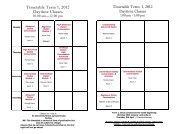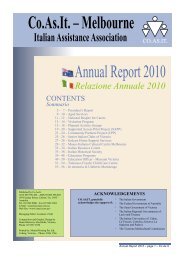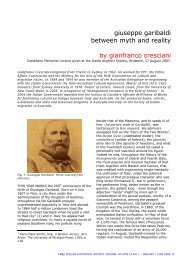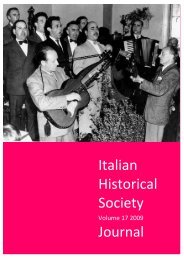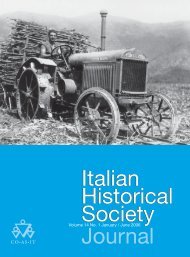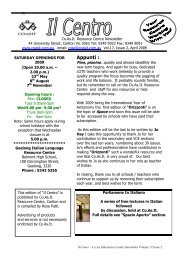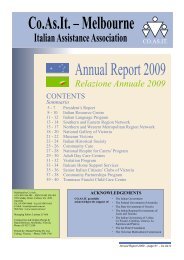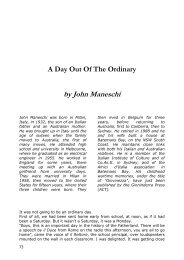signs of italian culture in the urban landscape of carlton
signs of italian culture in the urban landscape of carlton
signs of italian culture in the urban landscape of carlton
Create successful ePaper yourself
Turn your PDF publications into a flip-book with our unique Google optimized e-Paper software.
SIGNS OF ITALIAN CULTURE IN THE URBAN LANDSCAPE OF CARLTON<br />
Alongside major traffic <strong>in</strong>tersections was a<br />
network <strong>of</strong> secondary streets and lanes and<br />
it was here that unregulated build<strong>in</strong>g saw<br />
<strong>the</strong> speedy construction <strong>of</strong> densely packed<br />
dwell<strong>in</strong>gs amid poor sanitary conditions.<br />
These were <strong>the</strong> so-called slum pockets<br />
which would be earmarked for demolition<br />
<strong>in</strong> <strong>the</strong> 1930s. By <strong>the</strong> end <strong>of</strong> World War II,<br />
Carlton’s demographic makeup consisted<br />
ma<strong>in</strong>ly <strong>of</strong> large work<strong>in</strong>g class families liv<strong>in</strong>g<br />
<strong>in</strong> rented Victorian and Edwardian cottages.<br />
From its early days, Carlton has been a<br />
neighbourhood <strong>of</strong> new arrivals: Jews,<br />
Italians, Greeks, Lebanese and latterly<br />
Ethiopians have made it <strong>the</strong>ir first port <strong>of</strong><br />
call, mark<strong>in</strong>g <strong>the</strong>ir passage through Carlton<br />
with <strong>the</strong>ir own <strong>in</strong>delible style. Accord<strong>in</strong>g<br />
to historian Celest<strong>in</strong>a Sagazio, <strong>the</strong> Italian<br />
community established itself <strong>in</strong> Carlton <strong>in</strong><br />
three successive waves: <strong>the</strong> first phase<br />
occurred between <strong>the</strong> second half <strong>of</strong> <strong>the</strong><br />
n<strong>in</strong>eteenth century and World War I, <strong>the</strong><br />
second between <strong>the</strong> two World Wars and<br />
<strong>the</strong> third after World War II. The earliest<br />
arrivals were musicians from Basilicata<br />
<strong>in</strong> <strong>the</strong> south <strong>of</strong> Italy, followed by friuliani,<br />
trevisani and vicent<strong>in</strong>i from <strong>the</strong> north. The<br />
first arrivals settled <strong>in</strong> <strong>the</strong> heart <strong>of</strong> Carlton<br />
and to <strong>the</strong> south, while those who arrived<br />
after World War II, from Sicily, Calabria<br />
and Abruzzo, chose <strong>the</strong> north <strong>of</strong> Carlton.<br />
Toge<strong>the</strong>r, <strong>the</strong>se migrants formed <strong>the</strong> Italian<br />
community. Dur<strong>in</strong>g <strong>the</strong> 1950s, <strong>the</strong> Jewish<br />
population began to leave Carlton for o<strong>the</strong>r<br />
suburbs. These are <strong>the</strong> years when Italian<br />
settlement was at its most conspicuous:<br />
‘In <strong>the</strong> 1950s and 1960s, Carlton became<br />
<strong>the</strong> first and best known “Little Italy”<br />
<strong>in</strong> Australia. It was <strong>in</strong> many ways <strong>the</strong><br />
Italians’ home away from home. Some<br />
historians argue that by 1960 <strong>the</strong> various<br />
groups <strong>of</strong> Italian migrants had formed<br />
an Italo-Australian community. The<br />
concept <strong>of</strong> community was widely used<br />
by Italian newspapers, political leaders<br />
and by <strong>the</strong> public. The term embraced<br />
all people <strong>of</strong> Italian descent liv<strong>in</strong>g <strong>in</strong><br />
Australia. It assumed that <strong>the</strong>y had more<br />
<strong>in</strong> common with each o<strong>the</strong>r than with o<strong>the</strong>r<br />
Australians’. 4<br />
At this po<strong>in</strong>t one may ask why Carlton was<br />
<strong>the</strong> first port <strong>of</strong> call for many migrants. The<br />
majority <strong>of</strong> Italians migrat<strong>in</strong>g to Australia, as<br />
well as to o<strong>the</strong>r parts <strong>of</strong> <strong>the</strong> globe, did not<br />
arrive under <strong>the</strong> Australian government’s<br />
Assisted Passage Scheme. Instead,<br />
<strong>the</strong>y paid <strong>the</strong>ir own way, gravitat<strong>in</strong>g to<br />
those areas where o<strong>the</strong>r Italian migrants,<br />
sometimes from <strong>the</strong> same town, had<br />
already established <strong>the</strong>mselves. These<br />
established paesani helped new arrivals<br />
to f<strong>in</strong>d work and accommodation. Cha<strong>in</strong><br />
migration, hostility from <strong>the</strong> Anglo-<br />
Australian community, proximity to<br />
employment and <strong>the</strong> lack <strong>of</strong> assistance<br />
from <strong>the</strong> Australian government were all<br />
factors which guided <strong>the</strong> Italian migrant to<br />
Carlton.<br />
Initially, <strong>the</strong> majority <strong>of</strong> Italian migrants were<br />
male. Those from <strong>the</strong> north <strong>of</strong> Italy found<br />
employment <strong>in</strong> <strong>the</strong> construction <strong>in</strong>dustry,<br />
while sou<strong>the</strong>rners worked <strong>in</strong> sub<strong>urban</strong><br />
factories, market gardens or <strong>in</strong> <strong>the</strong><br />
hospital and clean<strong>in</strong>g sectors. Many were<br />
musicians, grocers, fruit and vegetable<br />
merchants, barbers, restaurateurs and<br />
bakers. Migrants from Friuli and Veneto<br />
were experts <strong>in</strong> terrazzo mak<strong>in</strong>g as well as<br />
bricklay<strong>in</strong>g and carpentry. Italian women<br />
<strong>in</strong> <strong>the</strong> ma<strong>in</strong> worked from home, tak<strong>in</strong>g <strong>in</strong><br />
sew<strong>in</strong>g or runn<strong>in</strong>g board<strong>in</strong>g houses for<br />
newly arrived migrants. From <strong>the</strong> 1950s<br />
onward, many Italian women also found<br />
work <strong>in</strong> <strong>the</strong> cloth<strong>in</strong>g and textile <strong>in</strong>dustry.<br />
In 1891, Italians represented 1% <strong>of</strong> <strong>the</strong><br />
population <strong>of</strong> metropolitan Melbourne and<br />
even by 1914 <strong>the</strong>ir numbers did not exceed<br />
100. However, between 1921 and 1947<br />
<strong>the</strong> Italian population rose dramatically<br />
from 237 to 1,612, and <strong>in</strong> June 1960 <strong>the</strong><br />
number soared to 5,000 or 20% <strong>of</strong> <strong>the</strong> total<br />
population <strong>of</strong> Carlton. Although <strong>the</strong>se are<br />
approximate figures for <strong>the</strong> municipality<br />
as a whole, <strong>the</strong>y <strong>in</strong>dicate a grow<strong>in</strong>g Italian<br />
presence <strong>in</strong> <strong>the</strong> area. As affirmed by<br />
demographer F Lancaster Jones:<br />
‘In 1945 only 14 shops <strong>in</strong> Lygon Street<br />
between Queensberry and Elg<strong>in</strong> Streets<br />
had Italian proprietors [….]. The 1960<br />
Melbourne directory lists 47 Italian<br />
shops <strong>in</strong> <strong>the</strong> same area, <strong>in</strong>clud<strong>in</strong>g n<strong>in</strong>e<br />
espresso bars, three hairdressers, three<br />
butchers, two electrical goods retailers,<br />
two photographers, two estate agents,<br />
a chemist, a florist, a motor mechanic, a<br />
large emporium, and even an Italian hotel<br />
proprietor. Elsewhere <strong>in</strong> <strong>the</strong> Carlton area, an<br />
Italian priest, Italian doctors and solicitors,<br />
and a multitude <strong>of</strong> Italian tradesmen<br />
completed what is for many Melbourne’s<br />
Italians a home away form home. For by<br />
<strong>the</strong> middle <strong>of</strong> 1960 at least one-quarter <strong>of</strong><br />
Carlton’s population was <strong>of</strong> Italian orig<strong>in</strong>’. 5<br />
Until 1971, <strong>the</strong> Italian-born population<br />
<strong>of</strong> North Carlton was 28.5%. Today, this<br />
percentage has dropped to 4%. From <strong>the</strong><br />
end <strong>of</strong> <strong>the</strong> 1960s, Carlton Italians moved to<br />
<strong>the</strong> outer suburbs where <strong>the</strong>y built spacious<br />
houses on larger blocks. None<strong>the</strong>less,<br />
ITALIAN<br />
HISTORICAL<br />
SOCIETY<br />
JOURNAL 3




